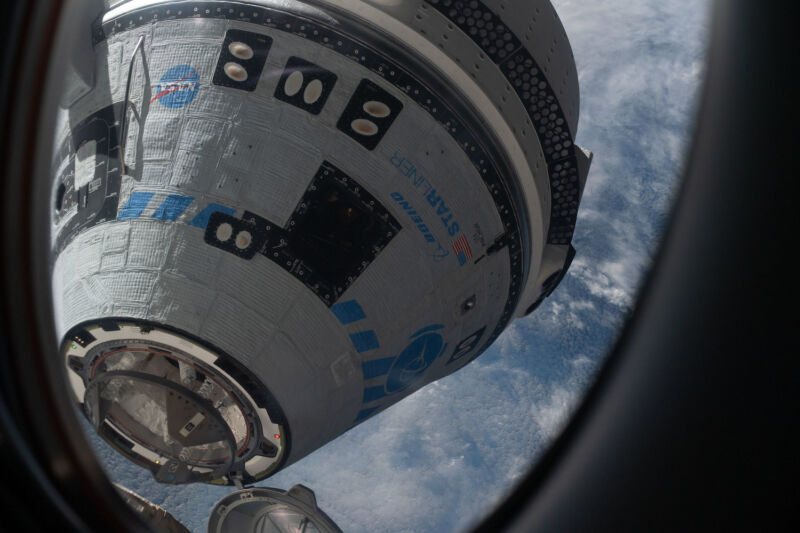

NASA
NASA and Boeing are proceeding with final preparations to undock the Starliner spacecraft from the International Space Station next Friday, September 6, to head for landing at White Sands Space Harbor in southern New Mexico.
Astronauts Butch Wilmore and Suni Williams, who were supposed to return to Earth inside Starliner, will remain behind on the space station after NASA decided last week to conclude the Boeing test flight without its crew on board. NASA officials decided it was too risky to put the astronauts on Starliner after the spacecraft suffered thruster failures during its flight to the space station in early June.
Instead, Wilmore and Williams will come home on a SpaceX Dragon capsule no earlier than February, extending their planned stay on the space station from eight days to eight months. Flying on autopilot, the Starliner spacecraft is scheduled to depart the station at approximately 6:04 pm EDT (22:04 UTC) on September 6. The capsule will fire its engines to drop out of orbit and target a parachute-assisted landing in New Mexico at 12:03 am EDT (04:03 UTC) on September 7, NASA said in a statement Thursday.
NASA officials completed the second part of a two-day Flight Readiness Review on Thursday to clear the Starliner spacecraft for undocking and landing. However, there are strict weather rules for landing a Starliner spacecraft, so NASA and Boeing managers will decide next week whether to proceed with the return next Friday night or wait for better conditions at the White Sands landing zone.
Over the last few days, flight controllers updated parameters in Starliner’s software to handle a fully autonomous return to Earth without inputs from astronauts flying in the cockpit, NASA said. Boeing has flown two unpiloted Starliner test flights using the same type of autonomous reentry and landing operations. This mission, called the Crew Flight Test (CFT), was the first time astronauts launched into orbit inside a Starliner spacecraft, and was expected to pave the way for future operational missions to rotate four-person crews to and from the space station.
With the Starliner spacecraft unable to complete its test flight as intended, there are fundamental questions about the future of Boeing’s commercial crew program. NASA Administrator Bill Nelson said last week that Boeing’s new CEO, Kelly Ortberg, told him the aerospace company remained committed to Starliner. However, Boeing will be on the hook to pay for the cost of resolving problems with overheating thrusters and helium leaks that hamstrung the CFT mission. Boeing hasn’t made any public statements about the long-term future of the Starliner program since NASA decided to pull its astronauts off the spacecraft for its return to Earth.
Preparing for a contingency
NASA is clearly more comfortable with returning Wilmore and Williams to Earth inside SpaceX’s Dragon capsule, but the change disrupts crew operations at the space station. This week, astronauts have been reconfiguring the interior of a Dragon spacecraft currently docked at the outpost to support six crew members in the event of an emergency evacuation.
With Starliner leaving the space station next week, Dragon will become the lifeboat for Wilmore and Williams. If a fire, a collision with space junk, a medical emergency, or something else forces the crew to leave the complex, the Starliner astronauts will ride home on makeshift seats positioned under the four regular seats inside Dragon, where crews typically put cargo during launch and landing.
At least one of the Starliner astronauts would have to come home without a spacesuit to protect them if the cabin of the Dragon spacecraft depressurized on the descent. This has never happened on a Dragon mission before, but astronauts wear SpaceX-made pressure suits to mitigate the risk. The four astronauts who launched on Dragon have their suits, and NASA officials said a spare SpaceX suit already on the space station fit one of the Starliner astronauts, but they didn’t identify which one.
A pressure suit for the other Starliner crew member will launch on the next Dragon spacecraft—on the Crew-9 mission—set for liftoff on a SpaceX Falcon 9 rocket no earlier than September 24. Starliner’s troubles have also disrupted plans for the Crew-9 mission.
On Friday, NASA announced it would remove two astronauts from the Crew-9 mission, including its commander, Zena Cardman, who is a spaceflight rookie. Veteran astronaut Nick Hague will move from the pilot’s seat to take over as Crew-9 commander. Russian cosmonaut Aleksandr Gorbunov will join him.
NASA and Russia’s space agency, Roscosmos, have an agreement to launch Russian cosmonauts on Dragon missions and US astronauts on Russian Soyuz flights to the station. In exchange for NASA providing a ride for Gorbunov, NASA astronaut Don Pettit will fly to the space station on a Soyuz spacecraft next month.
The so-called “seat swap” arrangement ensures that, even if Dragon or Soyuz were grounded, there is always at least one US astronaut and one Russian cosmonaut on the station overseeing each partner’s segment of the outpost, maintaining propulsion, power generating, pointing control, thermal control, and other critical capabilities to keep the lab operational.